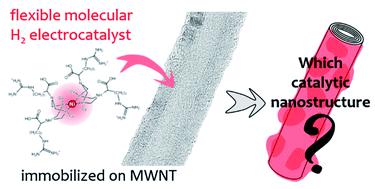当前位置:
X-MOL 学术
›
Chem. Sci.
›
论文详情
Our official English website, www.x-mol.net, welcomes your feedback! (Note: you will need to create a separate account there.)
How do H2 oxidation molecular catalysts assemble onto carbon nanotube electrodes? A crosstalk between electrochemical and multi-physical characterization techniques
Chemical Science ( IF 8.4 ) Pub Date : 2021-11-19 , DOI: 10.1039/d1sc05168g Ahmed Ghedjatti 1, 2, 3 , Nathan Coutard 1 , Laura Calvillo 4 , Gaetano Granozzi 4 , Bertrand Reuillard 1 , Vincent Artero 1 , Laure Guetaz 5 , Sandrine Lyonnard 3 , Hanako Okuno 2 , Pascale Chenevier 3
Chemical Science ( IF 8.4 ) Pub Date : 2021-11-19 , DOI: 10.1039/d1sc05168g Ahmed Ghedjatti 1, 2, 3 , Nathan Coutard 1 , Laura Calvillo 4 , Gaetano Granozzi 4 , Bertrand Reuillard 1 , Vincent Artero 1 , Laure Guetaz 5 , Sandrine Lyonnard 3 , Hanako Okuno 2 , Pascale Chenevier 3
Affiliation

|
Molecular catalysts show powerful catalytic efficiency and unsurpassed selectivity in many reactions of interest. As their implementation in electrocatalytic devices requires their immobilization onto a conductive support, controlling the grafting chemistry and its impact on their distribution at the surface of this support within the catalytic layer is key to enhancing and stabilizing the current they produce. This study focuses on molecular bioinspired nickel catalysts for hydrogen oxidation, bound to carbon nanotubes, a conductive support with high specific area. We couple advanced analysis by transmission electron microscopy (TEM), for direct imaging of the catalyst layer on individual nanotubes, and small angle neutron scattering (SANS), for indirect observation of structural features in a relevant aqueous medium. Low-dose TEM imaging shows a homogeneous, mobile coverage of catalysts, likely as a monolayer coating the nanotubes, while SANS unveils a regular nanostructure in the catalyst distribution on the surface with agglomerates that could be imaged by TEM upon aging. Together, electrochemistry, TEM and SANS analyses allowed drawing an unprecedented and intriguing picture with molecular catalysts evenly distributed at the nanoscale in two different populations required for optimal catalytic performance.
中文翻译:

H2氧化分子催化剂如何组装到碳纳米管电极上?电化学和多物理表征技术之间的串扰
分子催化剂在许多感兴趣的反应中显示出强大的催化效率和无与伦比的选择性。由于它们在电催化装置中的实施需要将它们固定在导电载体上,因此控制接枝化学及其对它们在催化层内该载体表面分布的影响是增强和稳定它们产生的电流的关键。本研究的重点是分子仿生的用于氢氧化的镍催化剂,它与碳纳米管结合,碳纳米管是一种具有高比面积的导电载体。我们通过透射电子显微镜 (TEM) 结合高级分析,用于对单个纳米管上的催化剂层进行直接成像,以及小角中子散射 (SANS),用于间接观察相关水介质中的结构特征。低剂量 TEM 成像显示催化剂的均匀、可移动覆盖,可能是纳米管的单层涂层,而 SANS 揭示了表面催化剂分布中的规则纳米结构,其附聚物可以在老化时通过 TEM 成像。电化学、TEM 和 SANS 分析共同绘制了一幅前所未有的有趣图景,分子催化剂在纳米尺度上均匀分布在最佳催化性能所需的两个不同群体中。
更新日期:2021-11-29
中文翻译:

H2氧化分子催化剂如何组装到碳纳米管电极上?电化学和多物理表征技术之间的串扰
分子催化剂在许多感兴趣的反应中显示出强大的催化效率和无与伦比的选择性。由于它们在电催化装置中的实施需要将它们固定在导电载体上,因此控制接枝化学及其对它们在催化层内该载体表面分布的影响是增强和稳定它们产生的电流的关键。本研究的重点是分子仿生的用于氢氧化的镍催化剂,它与碳纳米管结合,碳纳米管是一种具有高比面积的导电载体。我们通过透射电子显微镜 (TEM) 结合高级分析,用于对单个纳米管上的催化剂层进行直接成像,以及小角中子散射 (SANS),用于间接观察相关水介质中的结构特征。低剂量 TEM 成像显示催化剂的均匀、可移动覆盖,可能是纳米管的单层涂层,而 SANS 揭示了表面催化剂分布中的规则纳米结构,其附聚物可以在老化时通过 TEM 成像。电化学、TEM 和 SANS 分析共同绘制了一幅前所未有的有趣图景,分子催化剂在纳米尺度上均匀分布在最佳催化性能所需的两个不同群体中。



























 京公网安备 11010802027423号
京公网安备 11010802027423号